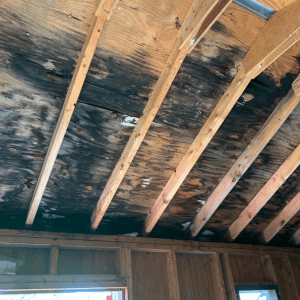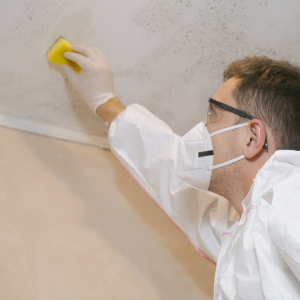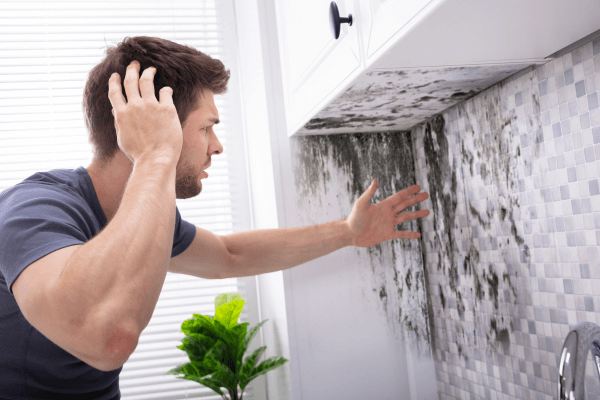Black mold can be a daunting problem for homeowners in San Antonio and surrounding areas like Alamo Heights, Stone Oak, and New Braunfels. Given our region’s warm and humid climate, conditions are often perfect for mold growth, especially in homes with poor ventilation or water damage. At Sapphire Restoration, we want to provide you with comprehensive guidance on how to get rid of black mold in your San Antonio home, ensuring you and your family can enjoy a healthy living environment once again.
Understanding Black Mold and Its Risks
Black mold, scientifically known as Stachybotrys chartarum, thrives in moist, humid conditions and can grow on various surfaces, including wood, drywall, and carpet. Here in San Antonio, with our long, hot summers and occasional heavy rains, the risk of black mold growth is significant. Exposure to black mold spores can cause serious health issues, including respiratory problems, allergic reactions, and even chronic illnesses in severe cases. Therefore, addressing black mold promptly and effectively is crucial for your health and home safety.
 Identifying Black Mold in Your Home
Identifying Black Mold in Your Home
Before you can get rid of black mold, you need to identify its presence. Here are some signs to look out for:
- Musty Odor: A persistent musty smell can indicate mold growth, even if you can’t see it.
- Visible Mold Growth: Black mold often appears as dark green or black patches on walls, ceilings, or floors.
- Water Damage: Areas that have experienced water damage are prime locations for mold growth.
- Health Symptoms: Unexplained respiratory issues, allergies, or other health problems may be a sign of mold exposure.
Local Climate Impact
San Antonio’s climate plays a significant role in mold growth. The combination of high humidity levels and warm temperatures creates an ideal environment for mold spores to thrive. During the summer months, when humidity levels can soar, the risk of mold growth increases, especially in poorly ventilated areas. After heavy rains, water intrusion can lead to hidden mold growth behind walls and under floors. Understanding these local climate factors helps identify and prevent mold issues.
Health Risks of Black Mold
Black mold can pose serious health risks, particularly for vulnerable populations such as children, the elderly, and individuals with respiratory conditions. According to the Centers for Disease Control and Prevention (CDC), exposure to black mold can lead to symptoms like coughing, sneezing, skin irritation, and more severe respiratory problems such as asthma attacks and chronic bronchitis. Long-term exposure may even result in neurological issues and immune system suppression. Addressing black mold promptly is crucial to safeguard your family’s health.
Exposure to black mold can also exacerbate existing health conditions. For individuals with asthma or other chronic respiratory diseases, black mold spores can trigger severe asthma attacks and reduce lung function. Allergic reactions can vary from mild to severe, including symptoms such as sneezing, runny nose, red eyes, and skin rashes. In some cases, exposure to mold can lead to infections, particularly in individuals with compromised immune systems. It’s essential to be aware of these risks and take immediate action if you suspect mold in your home.
DIY Mold Removal: When and How to Do It
If you identify small, isolated patches of black mold in your San Antonio home, you might be able to handle the removal yourself. However, remember that DIY mold removal is only suitable for areas smaller than 10 square feet. For larger infestations, it’s best to call in professionals like us at Sapphire Restoration.
Safety First!
Before you start the mold removal process, ensure you have the right protective gear:
- Gloves: Rubber gloves to protect your hands from mold spores and cleaning agents.
- Respirator: An N95 respirator to prevent inhaling harmful mold spores.
- Goggles: Safety goggles to protect your eyes.
DIY Mold Removal Steps
- Prepare Your Cleaning Solution:
- Mix one part white vinegar with one part water in a spray bottle. Vinegar is a natural and effective mold killer.
- Apply the Solution:
- Spray the vinegar solution generously on the moldy area and let it sit for at least 30 minutes to penetrate the mold.
- Scrub the Mold:
- Use a stiff brush to scrub the affected area thoroughly. Pay special attention to corners and crevices where mold might hide.
- Rinse and Dry:
- Rinse the area with clean water and dry it completely with a cloth or paper towel. Mold thrives in moisture, so ensure the area is completely dry.
When to Call the Professionals
For larger black mold infestations, particularly those exceeding 10 square feet, or if mold is growing in hard-to-reach areas like behind walls or under floors, it’s essential to hire professional mold remediation services in San Antonio. At Sapphire Restoration, we have the tools and knowledge to safely and effectively remove mold, preventing further spread and ensuring a healthy environment.
Choosing a Professional Mold Remediation Service
When selecting a mold remediation company in San Antonio, consider the following factors:
- Certification and Experience: Ensure the company is certified and has extensive experience in mold removal.
- Advanced Technology: Look for companies that use advanced tools like thermal imaging to detect hidden mold.
- Comprehensive Service: A good remediation company will not only remove the mold but also address the underlying moisture issues to prevent recurrence.
- Customer Reviews: Check online reviews and testimonials from previous clients to gauge the company’s reliability and quality of service.
Local Experts’ Insights
San Antonio residents trust local mold remediation experts who understand the specific challenges posed by the area’s climate. At Sapphire Restoration, we offer tailored solutions, leveraging our knowledge of local building structures and weather patterns. Our expertise ensures a thorough and effective mold removal process, giving you peace of mind.
 Preventing Future Mold Growth
Preventing Future Mold Growth
Once you’ve successfully removed black mold from your San Antonio home, take steps to prevent its return:
- Control Humidity: Use dehumidifiers and air conditioners to maintain indoor humidity levels below 60%.
- Improve Ventilation: Ensure proper ventilation in areas prone to moisture, such as bathrooms, kitchens, and basements.
- Fix Leaks Promptly: Address any plumbing leaks or water damage immediately to prevent mold-friendly conditions.
- Regular Inspections: Conduct regular inspections of your home, particularly in areas that are susceptible to mold growth.
Additional Tips for San Antonio Homeowners on How To Get Rid Of Black Mold
- Use Mold-Resistant Products: When renovating or building, opt for mold-resistant drywall and paint to reduce the risk of mold growth.
- Install Exhaust Fans: Ensure bathrooms and kitchens have functional exhaust fans to remove excess moisture from the air.
- Monitor Outdoor Drainage: Ensure your home’s gutters and downspouts direct water away from the foundation to prevent water intrusion.
FAQs About Black Mold
Q: Can I use bleach to remove black mold? A: While bleach can kill surface mold, it does not penetrate porous materials and may not be effective for deeper infestations. Vinegar is a safer and more effective option.
Q: How can I tell if mold is behind my walls? A: Signs of hidden mold include musty odors, water stains, and health symptoms like allergies. Professional mold inspectors can use tools like thermal imaging to detect hidden mold.
Q: What should I do if I find a large mold infestation? A: For large infestations, contact a professional mold remediation service like Sapphire Restoration to ensure safe and thorough removal.
Call Sapphire Restoration Today
Knowing how to get rid of black mold in your San Antonio home is crucial for maintaining a healthy living environment. While small mold patches can be handled with DIY methods, larger infestations require professional intervention. By following the prevention tips provided, you can minimize the risk of future mold growth and ensure your home remains a safe haven for you and your family. For the best results, always rely on local experts who understand the specific needs and challenges of San Antonio residents.
Remember, prompt action and proper remediation are key to protecting your home and health from the dangers of black mold. If you suspect a significant mold problem, don’t hesitate to contact Sapphire Restoration today. Your health and home deserve nothing less.

